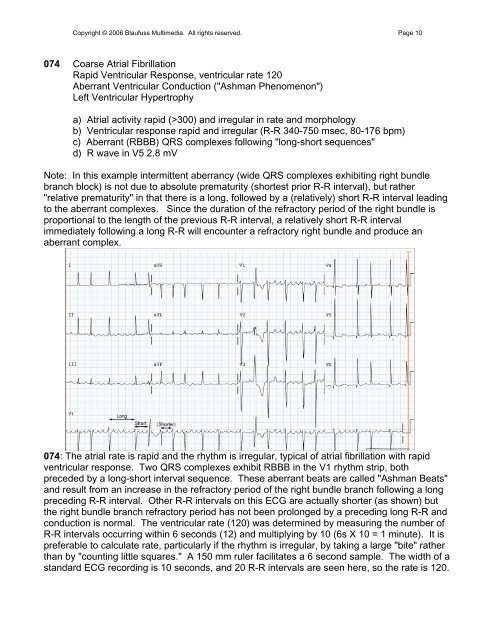002 Sinus Rhythm, atrial rate 90 Mobitz II - Blaufuss Multimedia
002 Sinus Rhythm, atrial rate 90 Mobitz II - Blaufuss Multimedia
002 Sinus Rhythm, atrial rate 90 Mobitz II - Blaufuss Multimedia
You also want an ePaper? Increase the reach of your titles
YUMPU automatically turns print PDFs into web optimized ePapers that Google loves.
Copyright © 2006 <strong>Blaufuss</strong> <strong>Multimedia</strong>. All rights reserved. Page 10<br />
074 Coarse Atrial Fibrillation<br />
Rapid Ventricular Response, ventricular <strong>rate</strong> 120<br />
Aberrant Ventricular Conduction ("Ashman Phenomenon")<br />
Left Ventricular Hypertrophy<br />
a) Atrial activity rapid (>300) and irregular in <strong>rate</strong> and morphology<br />
b) Ventricular response rapid and irregular (R-R 340-750 msec, 80-176 bpm)<br />
c) Aberrant (RBBB) QRS complexes following "long-short sequences"<br />
d) R wave in V5 2.8 mV<br />
Note: In this example intermittent aberrancy (wide QRS complexes exhibiting right bundle<br />
branch block) is not due to absolute prematurity (shortest prior R-R interval), but rather<br />
"relative prematurity" in that there is a long, followed by a (relatively) short R-R interval leading<br />
to the aberrant complexes. Since the duration of the refractory period of the right bundle is<br />
proportional to the length of the previous R-R interval, a relatively short R-R interval<br />
immediately following a long R-R will encounter a refractory right bundle and produce an<br />
aberrant complex.<br />
074: The <strong>atrial</strong> <strong>rate</strong> is rapid and the rhythm is irregular, typical of <strong>atrial</strong> fibrillation with rapid<br />
ventricular response. Two QRS complexes exhibit RBBB in the V1 rhythm strip, both<br />
preceded by a long-short interval sequence. These aberrant beats are called "Ashman Beats"<br />
and result from an increase in the refractory period of the right bundle branch following a long<br />
preceding R-R interval. Other R-R intervals on this ECG are actually shorter (as shown) but<br />
the right bundle branch refractory period has not been prolonged by a preceding long R-R and<br />
conduction is normal. The ventricular <strong>rate</strong> (120) was determined by measuring the number of<br />
R-R intervals occurring within 6 seconds (12) and multiplying by 10 (6s X 10 = 1 minute). It is<br />
preferable to calculate <strong>rate</strong>, particularly if the rhythm is irregular, by taking a large "bite" rather<br />
than by "counting little squares." A 150 mm ruler facilitates a 6 second sample. The width of a<br />
standard ECG recording is 10 seconds, and 20 R-R intervals are seen here, so the <strong>rate</strong> is 120.


